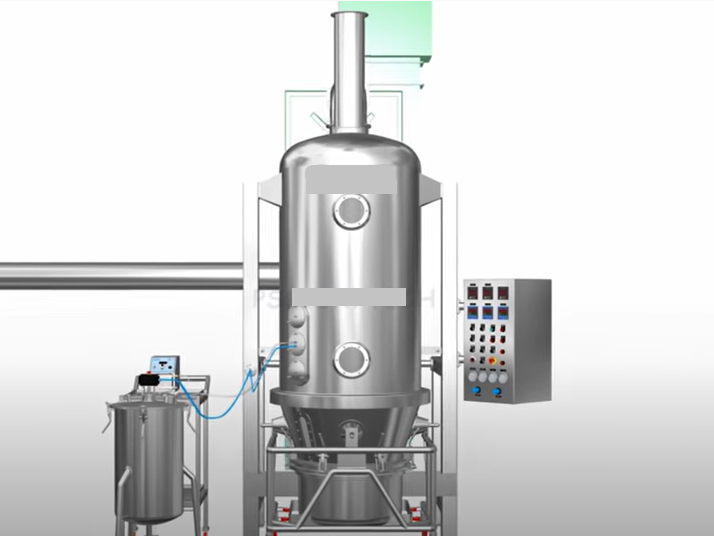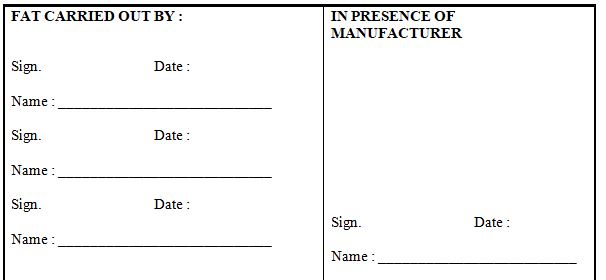Factory Acceptance Testing (FAT) makes sure that recently produced and packaged equipment serves the purpose for which it was designed. The FAT verifies the equipment’s functionality and confirms that all other requirements and the customer’s purchase order parameters have been met. Below is the detailed protocol for the Factory Acceptance Test of the Fluid Bed Processor.

Process flow for Factory Acceptance Test of the Fluid Bed Processor
1.0 APPROVAL
Initiated by:
| DESIGNATION | NAME | SIGNATURE | DATE | |
| Production Executive |
Checked by:
| DESIGNATION | NAME | SIGNATURE | DATE | |
| Validation Executive |
Reviewed by:
| DESIGNATION | NAME | SIGNATURE | DATE | |
| Quality Assurance Manager | ||||
| Quality Control Manager | ||||
| Manager Engineering | ||||
| Manager Production |
Approved by:
| DESIGNATION | NAME | SIGNATURE | DATE |
| GM QA /QC | |||
| GM Production |
1.0 Purpose:
1.1 To ensure that the dry heat sterilization tunnel is manufactured by (Company Name) is manufactured as per design specification.
1.2 The machine performs as per the agreed performance specification at the manufacturer’s site.
2.0 References:
2.1 Design Qualification of the machine obtained from the manufacturer.
2.2 Purchase Order No: EN/year / 1183, dated – XX.XX.XXXX.
2.3 User Requirement Specification Document No: AL/URF/XX(Year)/XX(serial no.).
3.0 Attachments
3.1 Drawing of the proposed installation Room, Room No.
4.0 Procedure for Factory Acceptance Test of the Fluid Bed Processor:
4.1 Take out the photocopy of the approved protocol for the Factory Acceptance Test of the Fluid Bed Processor to be carried out at the manufacturer’s site.
4.2 Carry out the tests mentioned in Table Number 1 at the manufacturer’s site & mention the observation in an “ACTUAL” column of the protocol photocopy.
4.3 In case of any additional information or mode of checking mentioned in the “REMARKS” column.
4.4 Check the basic installation & operation of the Fluid Bed Processor.
4.5 In case any deviation is observed during FAT, document it in the Observed deviation section.
4.6 Ensure that corrective action taken is meeting the user requirement specification.
4.7 If the deviation is acceptable, document it in the Observed Deviation section and provide proper justification.
4.8 If deviation is not acceptable, inform the manufacturer of the necessary action.
4.9 If the deviation is acceptable, provide final conclusion.
4.10 Ensure that the following listed documents are provided/ will be provided with the machine.
- User’s Manual
- Schematic electrical diagram
- Spare parts list
- MOC and test certificate of all parts of the machine from an accredited Lab.
- Supporting documents from the sub-suppliers.
4.11 Attach all relevant drawings, Manual, and Critical spare part lists with the FAT report.
Read Also: Multimill Design Qualifications in Pharma
5.0 Documentation for Factory Acceptance Test of the Fluid Bed Processor
5.1 All documentation work shall be completed concurrently during the execution of the FAT. However, the protocol does not define the sequence of the test/ documentation to be carried out.
5.2 Use indelible black/blue ink for the recording.
5.3 Fill out complete information in the format provided.
5.4 Do not leave any blank space.
5.5 Correct the wrong entry by drawing a single line through incorrect data, recording the correct data, and then signing and dating the change.
5.6 Enter “N/A” in a space that is not applicable.
5.7 During the protocol any deviation must be addressed and attended to as per the defined procedure.
5.8 During protocol execution, the report shall be prepared with the following details:
- Discussion of all studies in the observation column.
- FAT is completed or not
- Conclusion.
- Recommendation, if any.
6.0 Verification Criteria for Factory Acceptance Test of the Fluid Bed Processor :
| Table 1 | |||
| Item | Expectation | Actual | Remarks |
| Machine | (Company Name) Fluid Bed Processor FBE 500 | ||
| Make | (Company Name) and Address | ||
| Machine Dimensions | Length: 4255 mm Width: 1790 mm Height: 2300 mm | ||
| Type | Substances in powdery or granular form ( bulk materials ) into a suspended state. The fluidizing air in this equipment will enable a very efficient heat and mass transfer ( Heating, Cooling, Drying, Granulating ). | ||
| Capacity | 600 Litres. | ||
| Power supply | Three-phase 415 Hz, 50 Hz | ||
| Machine mounting | On sturdy SS 304 molded angles welded & grinded surface & fully cladded with SS sheets. | ||
| Machine Installation | Installation of the machine should be suitable as per the attached drawing. Compare the installation parameters with respect to room, pendant, drain, exhaust, etc. |
| Item | Expectation | Actual | Remarks |
| Product Container Trolley Material Trolley Wheels | SS 304 Nylon Wheel ( 2 Fix – 2 Swivel ) | ||
| Support Column Position Manufacturer Specification Material Surface Finish Winch Provided Foundation Bolts Column mounting Bolts Length and pitch | Lateral Support – Machine tower Pam (Company Name). Pvt. Ltd. Support column FBE 500 SS 304 Matt Finish ( Grit 120 ) Yes ( LHS ) SS 304 M12 X 140 long standard pitch | 0 | |
| Lower Plenum Position Manufacturer Specification Material Surface Inside Weld Inside Polished Material – Sealing Drain Point Provided Insulation | Inlet section – machine tower (Company Name). Pvt. Ltd. Lower Plenum FBE 500 SS 304 Matt Polished ( Grit 120 ) Yes Inflatable Silicone Gasket Yes No | ||
| Product Container Position Manufacturer Specification Material Surface Inside Weld Inside Polished Bottom Disconnect Material – SealingTamperature Probe Port Sample Port Window Material Sealing Material – Window Bottom Perforated Plate – Free Surface Quick Disconnect Bottom Sieve Mesh Size | |||
| Expansion Chamber Position Manufacturer Specification Material Surface finish -Inside Surface finish –outside Weld Inside Polished Material – Sealing Bull eye Window Window Material Sealing material – Window Spray Nozzle Port – Diameter Sealing Material – Nozzle Port Connection Charging Port Port Cleaning Nozzle – Material / Diameter Filter Wetting NozzlesTemperature Probe Port Connection Outlet Air Automatic Filter shaking Provided Explosion Relief plate sealing Material – Explosion Relief Plates | |||
| Clamping Assembly Position Manufacturer Specification Material Surface Inside Weld Inside Polished Material – Sealing | |||
| Inside Air Handler Manufacturer Specification Material Surface Inside Connection Inlet AirConnection outlet AirPre filter / Material Face & Bypass / Material Window Material Sealing material – Window |
| Item | Expectation | Actual | Remarks |
| Stabilizing / Cooling zone Length Cover MOC AC Drive make No of HEPA HEPA Size | 1595 mm SS 304 ABB 02 No EU – 13 915 x 762 mm | ||
| Conveyor Motor Make Type | Bonifiglioli Three-phase, aligned with a belt to the conveyor drive | ||
| Blowers Make Type | Airtech Engineers 3 Phase, 1 HP, 1400 RPM | ||
| Heating Element Make Type Size Capacity Resistance | (Company Name).‘U’ Type Heating Elements 1070 mm + 25 mm long 1500watts at 230 volts 35 ohms + 10 % at 230 volts |
| Item | Expectation | Actual | Remarks |
| PLC Make Model | Mitsubishi FX2N-32 MT | ||
| MMI Make Model | Beijers/ Mitsubishi E 615 | ||
| Printer Make Model | Epson LX – 300 Plus | ||
| Fresh Air Intake | Should be available with prefilters discharging before HEPA filters.Should be situated at least four feet above the floor surface. |
| Item | Expectation | Actual | Remarks |
| Pre Filters Type Make | Should be washable and reusable and Should be of reputed make | ||
| HEPA Filters Hot HEPA Make HEPA of DZ/SZ/CZ make | Klenzaids, Umbergaon Klenzaids, Umbergaon. | ||
| Magnehelic Gauges Make Range | Dwyer, USA 0 to 50 mm of water | ||
| RTDs Make Model Range | Radix PT 100 0 to 400 °C |
| Item | Expectation | Actual | Remarks |
| Proximity Sensors Type Make | Tubular Tecknic/Accent / Contrinex/IFM | ||
| Safety Features | Emergency Stop Independent Emergency Heater Cut-Off facility upon high temperature. Blowers not ON/ Tripped – Heater gets OFF. Different password levels (At least Three) in PLC for recipe setting and operation |
| Item | Expectation | Actual | Remarks |
| Additional Facilities Validation Ports View Ports in Drying, cooling and stabilizing zones | Should be available for giving in DOP smoke before HEPA for all zones Should be available with a lock and key | ||
| Item | Expectation | Actual | Remarks |
| Operational Interlocks | Intake and exhaust blowers cannot be switched OFF until the chamber temp is below the set point. Temp falls below-set point – Conveyor stops and restarts after the set delay after temperature achieving Filling machine LAF not operational – tunnel will not start Filling machine LAF trip – Conveyor stop In feed max accumulation – Washing machine stop Inadequate infeed – conveyor stops after a delay period Outfeed max accumulation – Conveyor stop immediately and the heater banks get off after a delay time. Any of the blowers OFF – Heater and conveyor get OFF Out feed vial temperature high – Conveyor stops |
| Item | Expectation | Actual | Remarks |
| Documents | The following document should be available/ will be available with the machine. MOC certificates of conveyor MOC of drying, sterilizing, cooling, and stabilizing zone chambers Test certificates of HEPA Filters (Efficiency and integrity) Test certificate of blowers Test certificate of Magnehelic gauges Test certificates of RTDs Test certificate of motors Operating and maintenance manual. As-built architectural, electrical, and P & ID drawing |
| 7.0 Performance at the site: | ||
| Operation | Observation | Remarks |
| Take a trial of the machine on the site by operating the machine with 7.5 ml tubular clear vials (24 mm dia). Vials are loaded on the infeed turntable of the washing machine, which will be carried forward to the infeed of the tunnel. From here the vial enters the tunnel and is carried forward by the conveyor. The vials should be carried smoothly through the tunnel to the outfeed. The conveyor speed should be adjustable from the operator interface. The heating should be controlled according to the set value on the operator interface. The heater bank is being controlled by the temperature of two temperature sensors in the sterilization zone. The set points and cycle data should be printed by the printer. The printing interval can be settable on PLC. The alarms are being displayed and acknowledged on the MMI. |
| Operation | Observation | Remarks |
| The recipe setting and operation should be with different password levels. The following parameters should be settable as a part of the recipe. Control Temperature (°C) Conveyor start temperature (°C) Conveyor stop temperature (°C) Conveyor start/restart delay (seconds) Start-up delay (seconds) Overshoot temperature (°C) Conveyor speed (mm/min) The following inputs should be required to start the process of the Tunnel Product – Alphanumeric 8-digit Batch Number – Alphanumeric 8-digit, Run Number – 04 digits Operator code – Alphanumeric 8 digit. |
| Operation | Observation | Remarks |
| Check for the following operational interlocks and their indication on MMI: Heater will not start if the blowers are not operational. Intake and exhaust blowers cannot be switched OFF until the temp in the sterilization chamber falls below the set value. Infeed max accumulation – Washing machine stop Outfeed max accumulation – conveyor stop and heater will stop after a set delay In adequate infeed – conveyor stop after a set delay time LAF over filling machine not operational – Tunnel will not start Blower of any zone tripped/ stopped – conveyor stop |
| Operation | Observation | Remarks |
| The machine should not make any abnormal sound or vibration during operation MMI & PLC support should be available during Auto operation. There should be a manual /maintenance mode/ validation mode in which the machine can be operated to perform maintenance activity / DOP tests/particle count etc. Before starting the tunnel the PLC should be required to enter the Product, Batch Number by the operator. The data printed by the printer should print the Product, Batch number, and recipe before the start of the cycle. The printer should also print every stage and alarm with the date irrespective of print interval time and temperature of the various zones as well as the conveyor speed at the set print interval. |
8.0 Deviation/ Discussion

9.0 Recommendation and Conclusion


